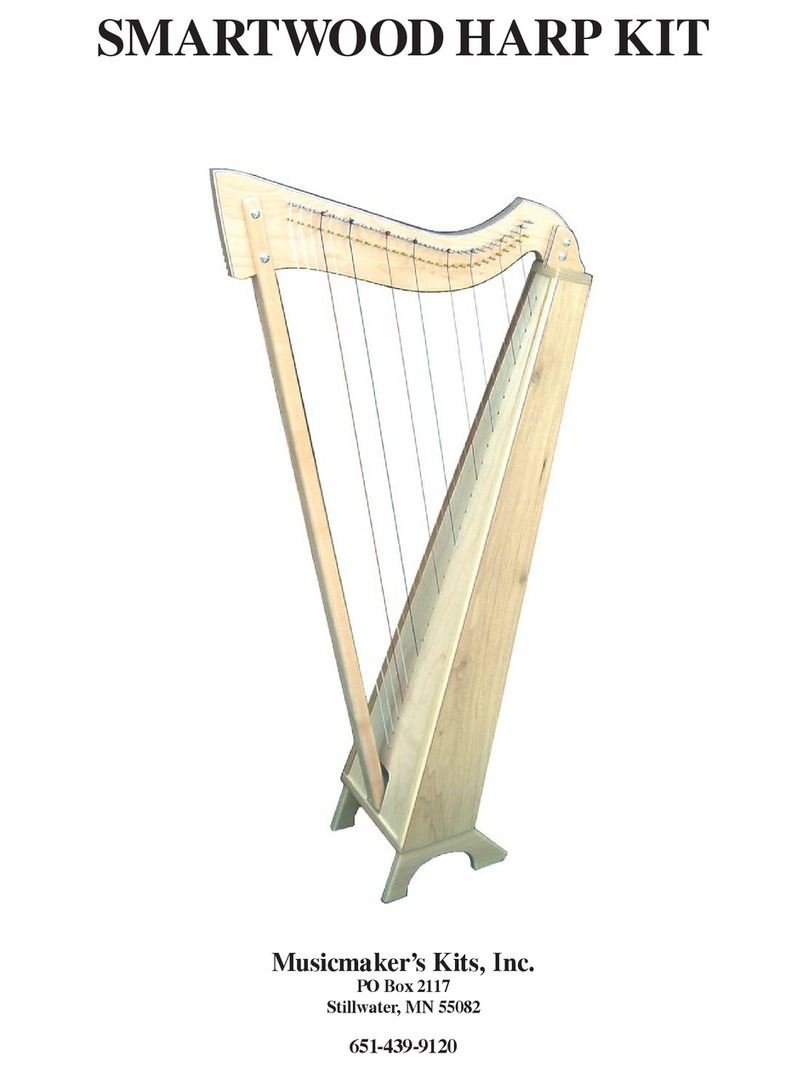
3/5/2010
7
IF YOU ORDERED A PARTIALLY ASSEMBLED KIT, BEGIN WORKING HERE:
____13. Use a medium (150 grit) sandpaper to smooth out all surfaces so they feel good to your
hand. Work the sandpaper with the grain so you don't scratch the surface.
Carefully check all the joints and glue seams to remove any glue residue that might remain visible,
because that will show up as ugly smudges under the finish.
____14. Sand the maple bridges to remove any rough spots. We like to leave the blackened insides
of the bridge “legs” for contrast. It looks great on the finished instrument.
____15. Notice that the
bridges have a few tiny
holes drilled along the tops.
These are for marking dots
to help guide you in your
playing. You need to fill
these holes with short
pieces of the black delrin
(plastic) rod provided in the kit. Push one end of the delrin rod into a hole and clip it off as close to
the wood as you can with a wire cutter. Repeat this procedure for each hole.
CAUTION: IF YOUR KIT HAS SEVERAL PIECES OF BLACK DELRIN, BE SURE TO
LEAVE TWO PIECES LONG ENOUGH TO SPAN THE LENGTH OF THE TWO BRIDGES.
____16. Sand these marking dots smooth with the surface of the bridges.
____17. When satisfied with your sanding, apply the finish of your choice. Here are a few
suggestions:
STAIN -- STAINS are coloring agents and should only be used if you dislike the natural color of the wood. We
usually do not apply stains to our projects, especially when they are made with naturally beautiful hardwoods
such as mahogany, cherry or walnut. These woods look very nice with just a clear finish. But, if you want to
color the wood differently, your staining should be accomplished before applying a surface finish such as oil,
varnish, or lacquer.
OIL -- An oil finish will give your wood a low luster appearance, bringing out the natural color of the grain,
but it tends soak into the wood and appear dry and "thirsty" after awhile. The principal advantage of an oil
finish is that it can be applied and wiped dry immediately, so you can proceed to installing hardware (and
strings) right away. The disadvantages of oil are that it usually does not give much surface protection or
sheen, although there are some brands that include waxes and/or varnishes to give more surface build-up
and luster.
VARNISH -- Any regular varnish will work fine on this project, but we recommend our wipe-on polyurethane
called MUSICMAKER'S INSTRUMENT FINISH. Our complete finishing kit (code FINISHKIT) includes detailed
instructions, sandpaper sheets, along with a 1/2 pint can of wipe on gel urethane varnish. The advantages of
finish are its simple application, durability, and deep, soft luster.
LACQUER -- Many professional instrument makers still use lacquer for their finish. The most readily
available lacquer is called Deft Clear Wood Finish. It is best to purchase a can of liquid to brush on as a
sealer coat first, and then use an aerosol can of the same product to spray on the final coats. The advantage
of this finish is its quick drying time, but the disadvantage is the strong odor of the toxic lacquer fumes.
CAUTION: Lacquer finish will not work over Heat Transfer decorations -- it dissolves the toner.
































